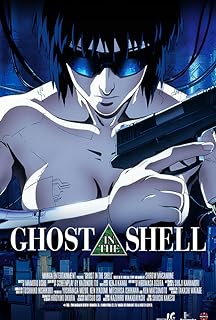電影訊息
電影評論更多影評

2015-02-13 22:05:17
Human’s Revolution in the Posthuman World: Ghost in the Shell
The 1995 animated film, Ghost in The Shell, directed by Oshii Mamoru, gives us a vivid picture of the so-called 「posthuman」 world (Orbaugh, Feb. 2) where human beings are no longer the only ones controlling there world, and cyborgs have become regular members of the population. Oshii expresses his worries towards the increasingly cyborgized human future in the film, but by having the leading character Kasanagi Motoko’s ghost merged with Puppet Master at the end, the filmmaker provides us a hopeful future where cyborgs are freed from their limiting bodies and begin to evolve.
In her article, Frankenstein and the Cyborg Metropolis, Orbaugh provides us the definition of cyborgs: 「an organic creature that has undergone technological mediation or enhancement (82).」 Cyborgs are deliberately created to do functions that beyond human beings』 ability. From my opinion, the progress of producing cyborgs is an active attempt of human towards evolution.
However, as we discussed in class (Feb. 11), unlike human beings, cyborgs are firstly designed, and then produced out of artificial materials and programmed data. They are never going to have the uniqueness that human beings hold the minute they are born. Kasanagi Motoko needs a mostly human guy, Tokusa, in her team, because she knows that human beings have their unique, distinctive reactions to events, unlike the cyborgs, who are products of the mechanical reproduction; they cannot react to events out of the way they are programmed. Oshii here expresses his worries towards the cyborgian future through Nasanagi’s words: 「a system where all the parts react the same way is a system with a fatal flaw (Ghost in the Shell, 1995).」 Evolution is all about survival of the fittest. Human have been through billions of years of biological evolution to come to today’s state, just like the revolution tree drawn on the wall in the museum. However, the new way of improving the human body, which is of course producing cyborgs, have the human jump over the process of natural selection; the graduate process of evolution is broken down by the invention of the cyborgs just like the revolution tree is destroyed by the bullets from the spider tank. This problematic choice of the human beings forces the cyborgs to seek for a way to evolve. Otherwise, 「overspecialization」 will lead them 「to death (Kasanagi, Ghost in the Shell, 1995).」
The director’s worry of the blind reliance on the cyborgs is also shown in the setting design. We see all the high technologies in the movie world, cyborgs, Internet, future firearms, etc., but the city still remains the same old. It is called the New Port city or the New Tokyo, but it looks exactly the same as the 1990s Hong Kong. The improvement of the human bodies does not bring the society itself to a brighter state. Not only the society, the flawed government and the human relationships remain the same as well. Puppet Master, who as a villain does all the crimes to the society, is born out of a conspiracy of the government. Even if the human bodies are improved, the greed is left. This is why a new way of evolution is needed immediately.
Nevertheless, the fundamental reason why cyborgs are not able to evolve is that they are artificial products that have not sex organs to reproduce by themselves. As long as they still hold their Ghosts, they are 「infinitely reparable and replicable (Orbaugh, 96),」 which means they can be immortal and there is no need for offspring. But the doubt on her own Ghost, which is her subjectivity, explained by Prof. Orbaugh (Feb. 11), is exactly what leads Kasanagi to her desire of reassuring her self-identity, and eventually to her acceptance of Puppet Master’s request of merging. Seeing the poor driver’s desperate face after he is told that all his memories of his family, wife and child are planted onto his ghost, Kasanagi starts to question whether the ghost she holds now is real. She wonders if she really exists or if it is just the impression of existence that the government prints onto their ghosts. Contrarily, the Puppet Master calls 「himself」 a life entity, even when 「he」 is born from a bugged program and does not have an actual body. Kasanagi does not really have any primary sexual characteristics, but she is still considered as a woman by others; whereas Puppet Master, who does not even have a body, is referred as a 「he」 in the film. To me, the act of Puppet Master merging himself into Kasanagi’s ghost is reflecting the sex behavior of the human beings. With Kasanagi being the 「mother,」 Puppet Master being the 「father,」 the result of their combination, the new Kasanagi becomes the 「child.」 The new way of reproduction is now established.
At the very end of the film, Kasanagi looks at the city, which looks just like the Net, and says, 「The Net is vast and infinite (Ghost in the Shell, 1995).」 1995, when the film was made, the Internet was not yet popularized into everybody’s home. Considering all the possibilities that the fresh new Internet could bring the human, Oshii imagines one most vivid picture: in the future, we are going to be able to live freely both in the reality and on the Internet; we will not be limited by our bodies anymore. This is the hopeful resolution of the posthuman society that Oshii pictures.
Work Cited
"Ghost in the Shell (film)." Wikipedia. Wikimedia Foundation. Web. 13 Feb. 2015. .
Ghost in the Shell. Dir. Oshii, Mamoru, Kazunori Itō, Kenji Kawai, et al. Manga Entertainment, 2004.
Orbaugh lecture, February 2, 2015.
Orbaugh lecture, February 11, 2015.
Orbaugh, Sharalyn. "Frankenstein and the Cyborg Metropolis: The Evolution of Body and City in Science Fiction Narratives." Palgrave Macmillan, 2006. 81.
評論

